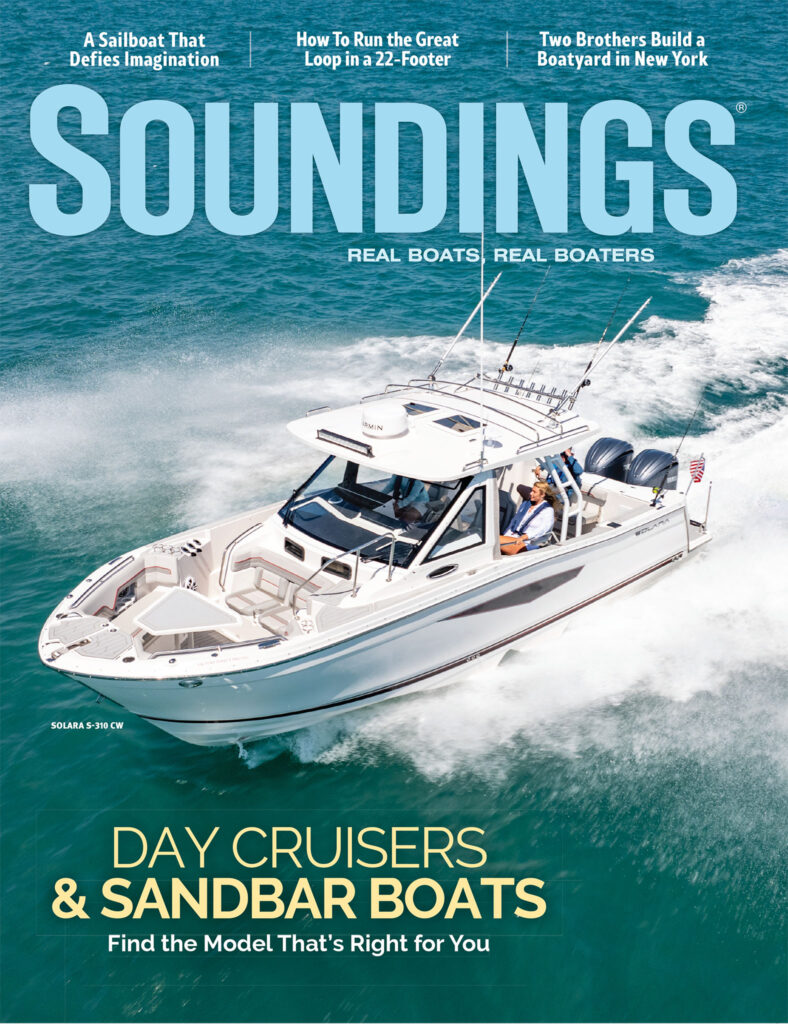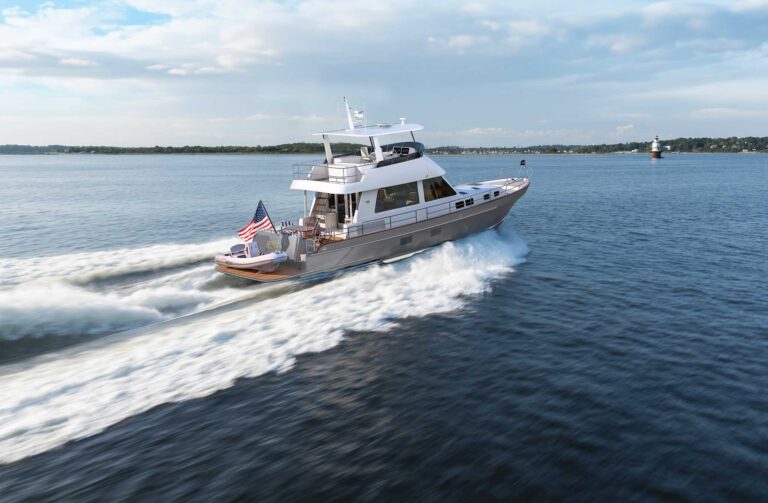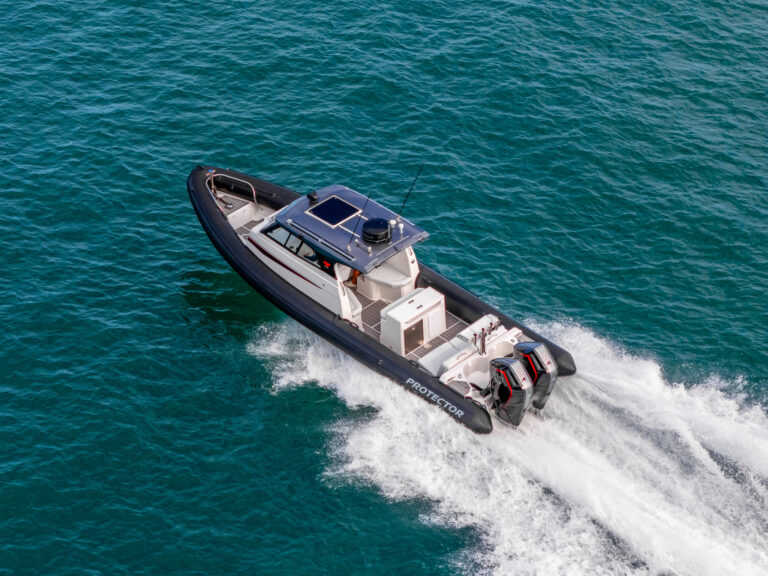The Virtual Lifeline is one of several new technologies designed to protect against prop injuries
The Virtual Lifeline is one of several new technologies designed to protect against prop injuries
Keith Jackson was headed for a go-fast rally on California’s Lake Havasu recently to meet with two high-performance boatbuilders who want his remote-control kill switches on their boats to prevent prop injuries.
“We’re getting calls all the time from manufacturers,” Jackson says.
High-performance boats go fast and can pound through waves, and skippers are aware of the dangers of a passenger being pitched out. Jackson, president of MariTech Industries of Redding, Calif., has developed wireless technology that alerts skippers when someone goes into the water, and automatically initiates countermeasures to avoid a prop strike in these and other potentially deadly situations.
Jackson’s company (www.maritechsafety.com ) manufactures a wireless lanyard called Virtual Lifeline. The helmsman and passengers wear a sensor about the size of a key fob, and if they fall into the water the sensor activates and radios a signal to a module on the boat. That sets off an alarm and shuts down the engines instantaneously.
Jackson says the device not only can help prevent prop injuries under way and aid in a quick recovery, but it addresses a common cause of prop injuries: starting the engine while swimmers still are in the water. The skipper can’t start the engine if any passengers are in the water and wearing the sensor. (There is a bypass to restart the engine if necessary — for example, to retrieve a person who has fallen overboard and can’t get back to the boat.)
“We’ve got two boat manufacturers who are putting them on as standard equipment,” Jackson says. “Another dozen boatbuilders are interested in it, either as an option or as standard gear.”
Professional bass anglers are leading the way in the use of the wireless lanyards. Many tournaments require participants to use an engine cutoff tether that attaches to their wrist or clothing so that if they are thrown out of the boat while under way the engine shuts down and the boat won’t just keep going or turn in a circle and run over the driver. Jackson says anglers like the wireless lanyards better than tethers, because the wireless units don’t tie them down.
“The tournament anglers are just eating this product up,” he says.
Sonar, radio-controlled kill switches, laser and other advanced technologies are coming online for boats and could replace prop guards as the preferred protection against debilitating propeller injuries. In addition to the wireless lanyard, Jackson manufactures a boarding ladder that protects swimmers from propeller injury by blocking the ignition when the ladder is in the down position, preventing the skipper from starting the engine.
Mercury Marine is working on several advanced technologies to prevent prop injuries and could introduce one or several of them in the next few years, according to Joe Pomeroy, Mercury’s general counsel. Pomeroy has helped defend the company in prop-strike law suits but also has been privy to the company’s work on new technology to protect against strikes.
Mercury (www.mercurymarine.com ) has maintained that prop guards — cages or sheaths around the propeller — are not a solution because they create handling problems in planing boats, as well as a larger underwater striking surface. Pomeroy says he hasn’t seen any advances in prop-strike technology in 20 years, but adds that some new approaches to preventing propeller injuries are in the wings.
He notes, however, that each technology has its limitations and the best protection against strikes could require using several of the technologies together. The challenges of detecting humans in the water are daunting. The boat is floating on an unstable surface, and the body is in two different media — water and air — that are different densities and temperatures. Whatever technology is used must be able to distinguish a person from other objects without a technician at the console to interpret the information. A microcomputer must do that.
Sonar appears to be one of the more promising technologies for alerting a skipper when a person is near the prop, Pomeroy says. However, it only works under water, and it’s hard for sonar to tell the difference between a swimmer and another boat, a rock or a fish, he says.
Infrared detection is another possibility, but the detector must be able to distinguish between heat from a human body and heat from the water or reflected sunlight, and to identify both a body in the water and a body coming out of the water. Laser, often used in security systems to detect intruders, also can be used to detect bodies in the water, but lasers usually detect movement and water is a constantly moving environment. Another way to detect people in the water is by looking for interruptions in an electromagnetic field off the stern, a technology Mercury also has been studying, Pomeroy says.
“All of these have advantages and technological challenges that we are trying to overcome,” he says. “All have the potential to eliminate contact with a turning prop. Making them work is the tough part.”
Pomeroy says it’s possible Mercury will have something on the market in the next couple of years. It more than likely will be a combination of technologies, each making up for weaknesses in the others. He expects Mercury will be able to introduce technology that is cost-effective, but it probably won’t be one-size-fits-all.
“There probably will be different types for different boats,” he says.
A special Coast Guard statistical study for SPIN, a group that advocates for reduced propeller-related injuries
(www.spin-site.org ), found that from 1998 to 2002 there were 812 prop- or engine-strike accidents reported in the United States, and 162 prop- or engine-strike fatalities. Most of these accidents were broadly categorized as hits by an engine or prop (43 percent). Thirty-one percent were falls overboard resulting in a prop strike, and 10 percent were strikes involving skiers, SPIN says.
This spring the National Boating Safety Advisory Council recommended that the Coast Guard take steps to reduce the number of prop-related injuries now. One is to develop for the 2007 boating season educational materials that all rental powerboat businesses would have to give customers to read before renting a boat. The Coast Guard is seeking the legislative authority to do that.
NBSAC also wants the Coast Guard to adopt some new rules. One would require powerboat manufacturers to install engine cutoff devices on new boats. Others would mandate that boat operators use engine cutoff tethers or wireless devices when the engine is running, and that they shut down the engine when a swimmer is near the boat. NBSAC also has recommended that the Coast Guard undertake a research project to test prop-guard technology.
MariTech’s Jackson says it’s all to the good. “You’ve got the potential to save some lives,” he says.










